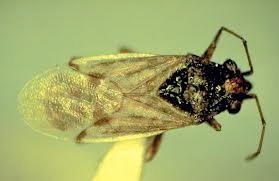ManageSafe™
Least-Toxic Control of Chinch Bugs Choose a different pests

|
Factsheet: Least-Toxic Control of Chinch Bugs
Identification
Pest type: Insects
In-depth Information:
Adult chinch bugs are almost 3/16-inch long, have black bodies and fully developed wings that appear frosty-white except for distinctive triangular black patch-like markings at the middles of the outer margins. Adults appear as either long-winged or short-winged forms.
Is it a problem?
Lawn damage is caused mainly by young chinch bugs, called nymphs. In turfgrass areas, injury typically appears as yellow or dead drought-stressed or heat-stressed spots in the yard, most commonly in July and August. Infestations are usually initially localized because chinch bugs feed in aggregates.
Pest prevention practices
Foster natural resilience
In-depth Information:
Chinch bugs prefer sunny lawns. Discourage infestation by shading your lawn with trees and shrubs.
Monitoring and record-keeping
Test for chinch bugs by cutting the bottom out of a coffee or other metal can. Place into a yellowed patch of grass in the sun, about two inches deep into the soil. Fill with water. If infested, dead chinch bugs will float to the top within five minutes.
Non-chemical and mechanical controls
Proper watering
Dethatching
Properly water and fertilize your lawn.
Add agricultural limestone when the soil pH is below 6.5
Use home ingredients by spraying a mixture of soap and water over damaged or suspect regions and then placing a white flannel cloth over the area. Drenching the area will force the chinch bugs up and out of the grass where they will proceed to cling to the cloth for easy collection and disposal.
Biological controls
Bigeyed bugs, Geocoris spp., are a natural predator of the chinch bug, however these usually do not build up large populations until considerable turf damage has already occurred.
Least-toxic chemical options as a last resort
- Insecticidal soap can be used, but with caution, as it is possible for these soaps to also kill beneficial insects.
- Diatomaceous earth (DE) kills chinch bugs by causing them to lose moisture and die. Be sure to purchase food grade DE.
Chemicals to Avoid
Look at your product labels and try to avoid products containing those chemicals listed below:
(A = acute health effects, C = chronic health effects, SW = surface water contaminant, GW = ground water contaminant, W = wildlife poison, B = bee poison, LT = long-range transport)
|
Acephate Bifenthrin Carbaryl | Clothianidin Cyfluthrin Cypermethrin | Deltamethrin Imidacloprid Lambda-cyhalothrin | Permethrin Thiamethoxam Trichlorfon |
Social Media
See what other folks are saying about this, and let us know what works for you.
Click the post above to view and comment on Facebook, or comment directly on this site below.








